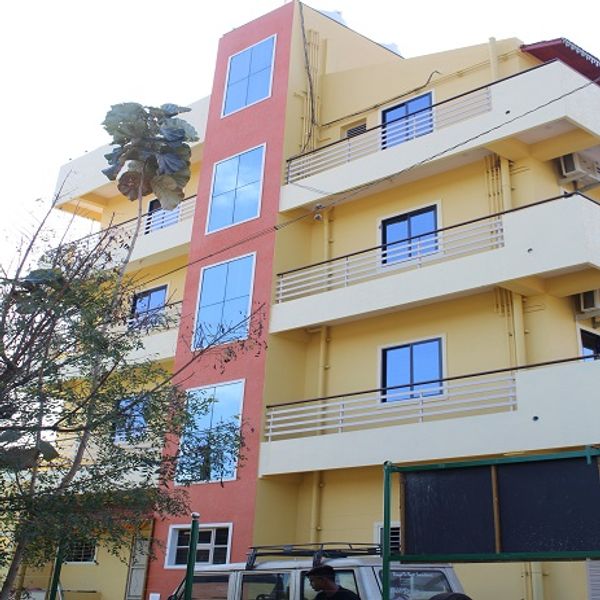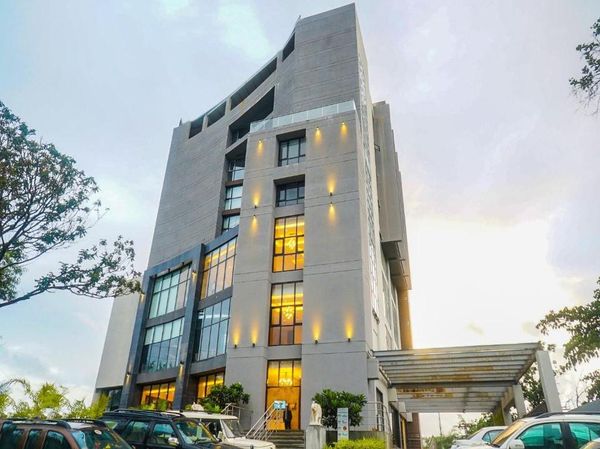Triveni Ghat, Rishikesh - All You Need To Know
 Mountains Curve
23 Jul, 2025
28 mins read
513
Mountains Curve
23 Jul, 2025
28 mins read
513
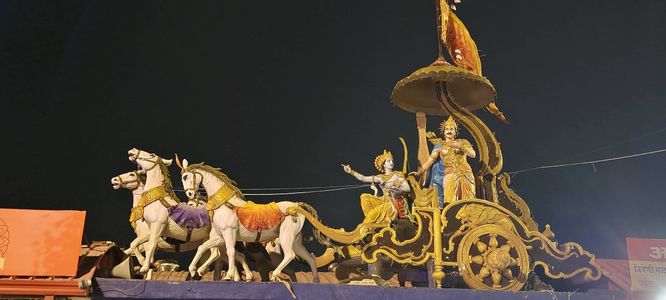
Overview: Triveni Ghat is a major riverside ghat on the holy Ganges in Rishikesh, famed as the spot where three sacred rivers (Ganga, Yamuna and the mythical Saraswati) meet. Pilgrims flock here to bathe in the Ganges, believing the waters have the power to purify and wash away sins. The ghat very name Triveni means three streams, reflecting this holy confluence. Lush hills frame a broad set of stone steps leading down to the river, making it both spiritually uplifting and scenically beautiful. Because of its size and location, Triveni Ghat is often considered the largest bathing ghat in Rishikesh.
Legend and Mythology: Triveni Ghat has deep roots in Hindu legend and scripture. It is mentioned in the Ramayana and Mahabharata and is linked to tales of Lord Rama and Lord Krishna. Local lore holds that Lord Rama sought atonement here for the sin of killing a Brahmin, and that Lord Krishna (after being wounded by an arrow) visited Triveni to cleanse himself. A small shrine (chatri) commemorates Krishna at the ghat, and some traditions even call it the cremation ground of Krishna. Saints have taught that pouring water or offerings into the Ganges at Triveni brings peace to ancestors, making it a popular site for Shraddha or Pind Daan rituals. Temples such as the Gita Mandir and Laxmi Narayan Temple stand on the banks here, underlining the enduring sanctity of area.
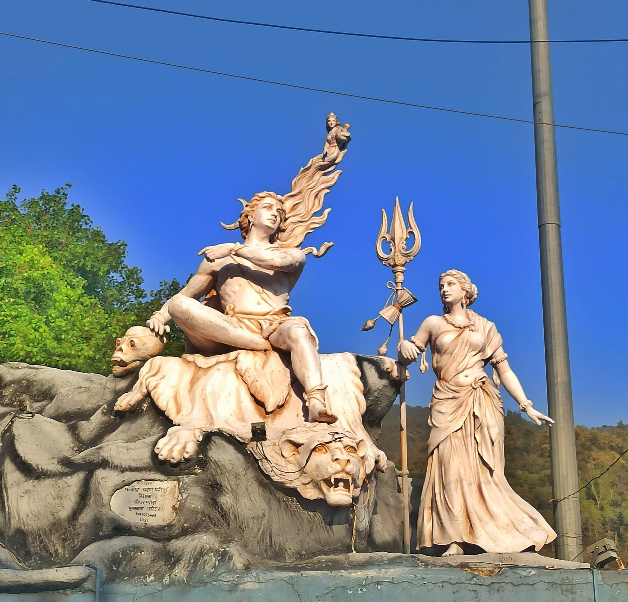
Evening Ganga Aarti at Triveni Ghat
The most famous daily ritual at Triveni Ghat is the Ganga Aarti (Maha Aarti) held each evening around sunset. Priests begin around 6:00 to 7:00 PM by lighting rows of oil lamps (diyas) and ringing bells while chanting hymns to the river goddess.

Devotees release small leaf boats with burning lamps into the Ganges, so that the river is dotted with these little burning flames. The glowing lamps, rhythmic drums and devotional chants create a mesmerizing, almost surreal atmosphere on the water. Even non-devotees find the ceremony moving, as one traveler noted, the chants here mesmerize you during Aarti. The Aarti lasts about 45 minutes every evening and is consistently listed as a must-see on Rishikesh itineraries.
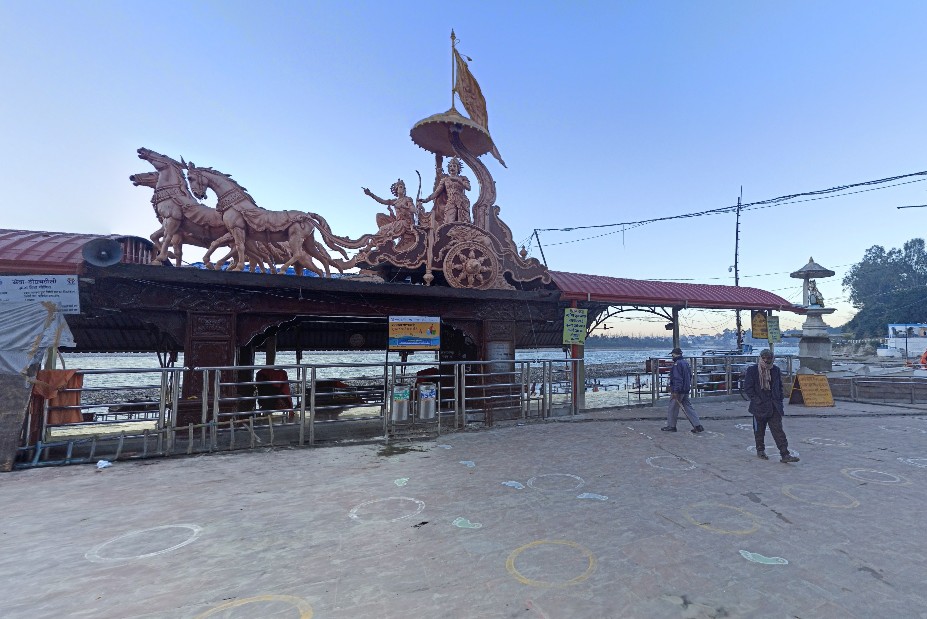
Other Rituals & Activities
Beyond the Aarti, Triveni Ghat offers a variety of spiritual activities:
- Holy dip in the Ganges: Devotees bathe at dawn or dusk, since taking a dip here is believed to wash away sins and bring spiritual merit. Early morning is especially popular for ritual bathing.
- Pind Daan (Shraddha rites): Many pilgrims perform Shraddha ceremonies at Triveni Ghat, offering food and water to honor deceased ancestors. It is said that giving these offerings here brings peace and prosperity to the ancestors souls.
- Offerings & feeding fish: At sunrise, worshippers often pour milk and water into the river and offer grains or bread to feed the thousands of fish at the ghat. This simple ritual of offering milk and watching fish gather, is a cherished part of the morning ceremony.
- Photography and sunrise/sunset: The wide river views of Ghat make it ideal for sunrise and sunset photos. The sight of hundreds of lamps on the water after dark is particularly stunning. Many visitors simply sit on the steps to watch the sun rise or set over the Ganges, soaking in the peaceful ambiance.
- Boat ride on the Ganga: Visitors can also take a short boat ride from Triveni to float on the Ganges and admire the ghat and nearby temples from the water. An early-morning or evening boat trip offers a different perspective on the Aarti flames reflecting on the river.
- Temples and local market: Two notable temples, Gita Mandir and Laxmi Narayan Temple, lie on either side of the ghat. Walking around, you will find stalls selling puja items (lamps, incense, flowers), local handicrafts (Kullu caps, brass idols) and snacks (sweets, golgappas). Exploring these shops is a nice complement after the rituals.
Visiting Tips and Practical Info
- Timings and Entry: Triveni Ghat is open daily from around 5:00 AM to 9:00 PM. There is no entry fee, so anyone can visit at any time (many arrive early for sunrise or just before the evening Aarti).
- Best time to visit: The peak season is October through March when the weather is cool and clear. Even in summer (April to June) the ghat is open, but it can get very hot; monsoon (July to Sept) brings heavy rains but a lush landscape. Regardless of season, plan to be at the ghat by 6pm for a good spot at Aarti.
- Dress code: As a sacred site, dress modestly. Cover shoulders and knees (men in long pants, women in longer skirts or salwar kameez). Carry a scarf or shawl if wearing lighter clothing.
- Facilities: There are limited changing rooms and restrooms near the ghat (a few basic washrooms). Changing facilities for women are scarce, so many female visitors change in private or wear easy outfits.
- Respect and cleanliness: Triveni Ghat is maintained by the state and local volunteers, please help keep it clean. Use designated areas for bathing and avoid littering in the river.
- Safety: The Ganges currents can be strong, especially in monsoon, so swim or wade only where locals do. Children should be supervised.
How to Reach Triveni Ghat, Rishikesh
Triveni Ghat is located in central Rishikesh, on the western bank of the Ganga. It is easily reached from the town:
Distance from Key Landmarks
- From Ram Jhula: ~6 km (15 to 20 minutes by vehicle)
- From Lakshman Jhula: ~9 km (25 to 30 minutes)
- These popular religious suspension bridges are often visited along with Triveni Ghat and can be included in the same day itinerary.
By Air to Nearest Airport
The closest airport to Rishikesh is Jolly Grant Airport (Dehradun), situated approximately 30 to 35 kilometers away.
- Travel time to Rishikesh: 45 to 60 minutes by cab or local bus.
- Flight connectivity: Direct flights are available from major cities like Delhi and Lucknow. Several airlines also operate connecting flights from Mumbai, Chennai, Hyderabad, Bangalore, and Pune.
- Tip: It is advisable to pre-book airport taxis or use reliable ride-hailing apps for a smoother arrival.
By Train to Nearest Railway Stations
- Rishikesh Railway Station: Located just 3 km from Triveni Ghat. Limited train connectivity.
- Haridwar Railway Station (Recommended): About 25 kilometers away, with excellent connectivity to metro cities such as Delhi, Mumbai, Varanasi, Kolkata, and Lucknow.
- From Haridwar to Rishikesh:
- By cab: 30 to 35 minutes
- By bus: 45 to 50 minutes (frequent service)
- By shared auto: Economical option for solo travelers
By Road to Buses and Taxis
Rishikesh is well-connected via road to major North Indian cities.
- From Delhi: 5 to 6 hours via NH 334 (approx. 240 km)
- Bus options: Regular, deluxe, semi-sleeper, and luxury AC buses are available from Kashmere Gate ISBT in Delhi.
- From Haridwar: Only 45 minutes by bus or 30 minutes by cab.
Most buses drop you at Rishikesh Bus Stand, from where Triveni Ghat is a short rickshaw ride or 10 to 15 minute walk.
Local Transportation in Rishikesh
Once you are in Rishikesh, reaching Triveni Ghat and nearby attractions is quite simple:
- Auto-rickshaws and e-rickshaws are readily available for short distances.
- Cycle rickshaws are perfect for leisurely local tours.
- Taxis and cabs (private or shared) can be booked for half or full-day city tours.
- Bike rentals are also available for adventurous travelers wanting to explore at their own pace.
Travel Duration to Rishikesh from Major Cities
From Chennai to Rishikesh
- By Air: ~5 hours (including layover; no direct flight)
- By Road: ~39 hours (approx. 2,400 km)
- By Train: ~40 hours (via multiple transfers)
- By Sea: Not applicable
From New Delhi to Rishikesh
- By Air: ~1 hour (direct flights to Dehradun)
- By Road: ~5 hours (approx. 240 km via NH334)
- By Train: ~9 hours (Delhi to Haridwar/Rishikesh)
- By Sea: Not applicable
From Hyderabad to Rishikesh
- By Air: ~3 hours (via Dehradun, one stop)
- By Road: ~29 hours (approx. 1,600 km)
- By Train: ~31 hours (via Haridwar)
- By Sea: Not applicable
From Kolkata to Rishikesh
- By Air: ~4 hours (with layovers)
- By Road: ~28 hours (approx. 1,500 km)
- By Train: ~26 hours (via Haridwar or direct)
- By Sea: Not applicable
From Mumbai to Rishikesh
- By Air: ~2 hours (to Dehradun, direct)
- By Road: ~27 hours (approx. 1,600 km)
- By Train: ~24 hours (direct and connecting options)
- By Sea: Not applicable
Pro Travel Tips
- Carry a Rishikesh tourist map (available locally and online) to navigate between temples, ghats, and markets.
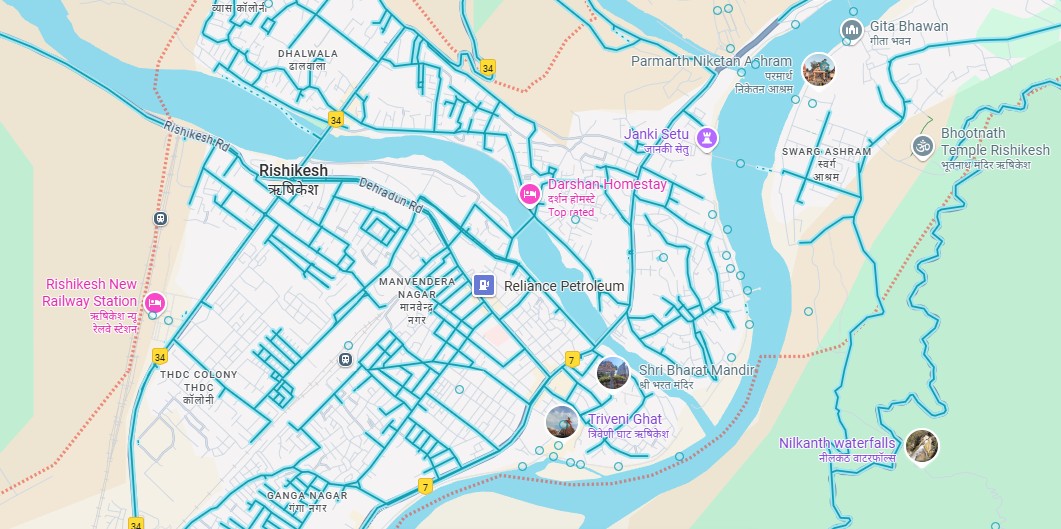
- Many spiritual and religious sites are located within walking distance of each other.
- Avoid travel during peak afternoon heat to early mornings and late afternoons are ideal for exploring.
- During festival seasons like Makar Sankranti or Ganga Dussehra, it is wise to book transportation in advance due to high footfall.
Other Places to Visit in and around Rishikesh
Parmarth Niketan

Parmarth Niketan is one of the largest and most serene ashrams in Rishikesh, known for its spiritual ambiance and riverside setting. It hosts daily yoga sessions, meditation classes, and satsangs, attracting both Indian and international visitors. The highlight here is the evening Ganga Aarti held at the private ghat of ashram, which is slightly more intimate and serene than the one at Triveni. The ashram also features a massive statue of Lord Shiva seated in meditation by the riverbank to an iconic image often associated with Rishikesh. Visitors can stay at the ashram for spiritual retreats or simply visit during the day to enjoy the peaceful gardens and temples. With a focus on simplicity, discipline, and devotion, Parmarth Niketan provides a perfect blend of ancient spiritual practices and modern wellness offerings. It is a place where seekers can deepen their inner journey while staying connected to the sacred energy of the Ganges.
Lakshmi Narayan Temple

Located near Triveni Ghat, the Lakshmi Narayan Temple is a quiet yet spiritually potent place dedicated to Lord Vishnu and Goddess Lakshmi. Its simple architecture and tranquil environment attract those looking for a peaceful moment away from the crowds. Inside, beautiful idols of Lakshmi and Narayan are adorned with traditional garments and jewelry, while the air resonates with soft devotional chants and the occasional ringing of temple bells. The temple is especially popular during Hindu festivals like Diwali and Janmashtami. Daily aartis and rituals take place in the early morning and evening hours, and you can often see locals offering flowers, incense, and sweets as part of their devotion. Its location along the Ganga adds to its spiritual charm. Many visitors stop here after performing rituals at Triveni Ghat, making it part of a complete spiritual experience. The calm ambiance of temple is perfect for short meditation or prayer.
Bharat Mandir
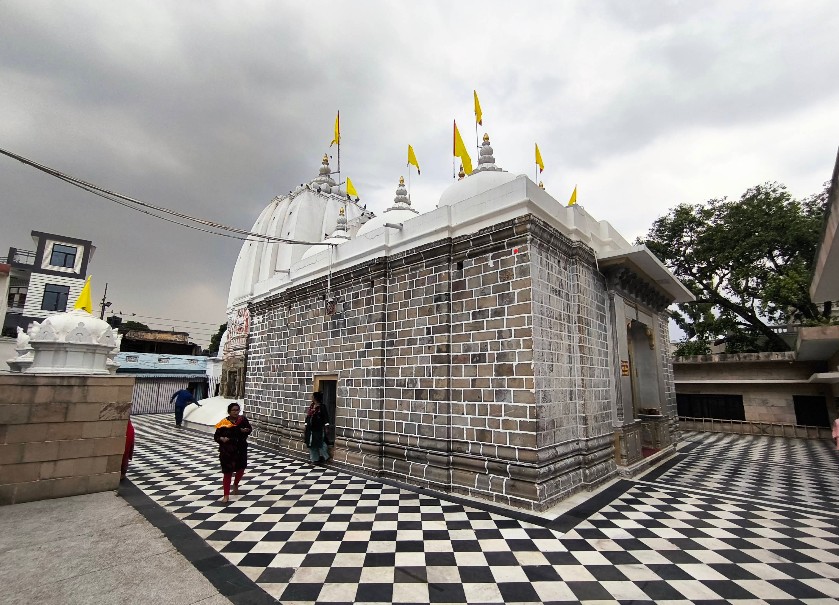
Bharat Mandir is one of oldest and most significant temples of Rishikesh, believed to have been established by Adi Shankaracharya in the 9th century. Located in the heart of the city, this temple is dedicated to Lord Vishnu, worshipped here as Bharat, brother of Lord Ram. The sanctum houses a single black stone Shaligram idol, which is said to have been retrieved from the Alaknanda River. During the festival of Basant Panchami, the idol is ceremoniously taken out for a sacred dip in the Ganga, drawing large crowds of devotees. The temple also houses ancient relics and inscriptions, making it an intriguing spot for history and archaeology enthusiasts. Quiet yet powerful in its spiritual presence, Bharat Mandir is a perfect example of ancient Indian temple architecture and faith. It is a must-visit for those wanting to explore Rishikesh beyond its ashrams and riverbanks.
Trayambakeshwar Temple (TeraManjila Shiv Mandir)
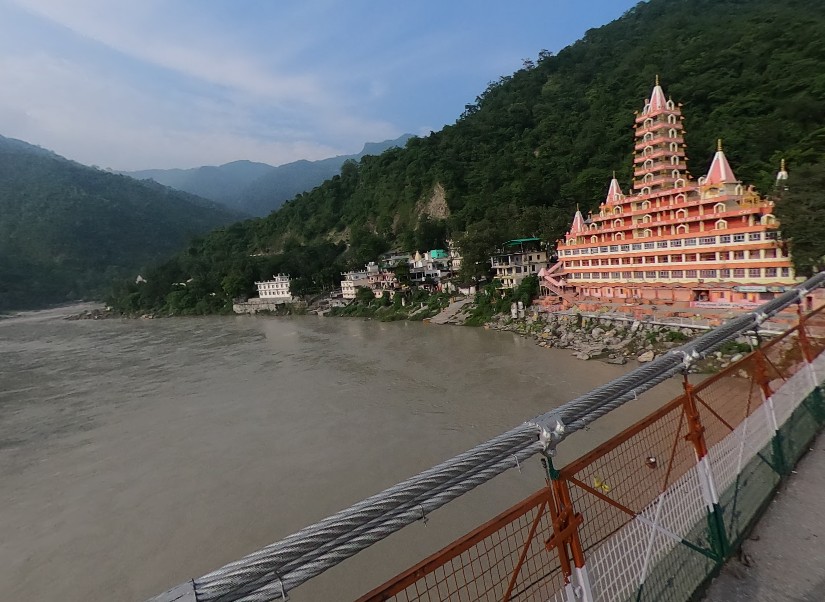
Towering 13 stories high near Laxman Jhula, the Trayambakeshwar Temple to often called Tera Manjila Mandir to is one of the most iconic spiritual structures in Rishikesh. Each floor houses different deities, making the climb a pilgrimage in itself. At the very top, you are rewarded with panoramic views of the Ganges and surrounding hills. The temple is dedicated to Lord Shiva but features shrines for Vishnu, Durga, Hanuman, and other Hindu gods, giving devotees a chance to offer prayers to multiple deities in one visit. The architecture is vibrant and colorful, and the chanting of mantras as you ascend adds a spiritual rhythm to the climb. The experience is not only about religious worship but also about inner reflection. Vendors and shops line the base, offering prasad and souvenirs. Visiting at sunrise or sunset offers both spiritual and visual beauty, as the temple glows in the changing light with the Ganga flowing below.
Rafting in Rishikesh
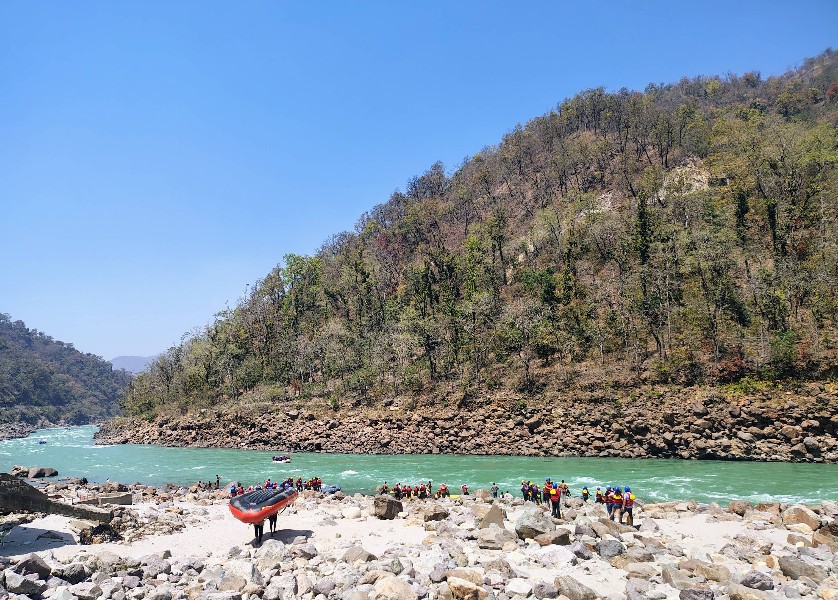
Rishikesh is one of premier white-water rafting destinations of India, offering thrilling rides along the turbulent stretches of the Ganga. With rapids ranging from Grade I to IV, rafting here is suitable for both beginners and seasoned adventurers. Popular routes include Brahmapuri to Rishikesh (ideal for first-timers) and the more challenging Marine Drive to Lakshman Jhula stretch. The experience combines adrenaline with the breathtaking beauty of Himalayan forests, riverside temples, and sandy banks. Rafting season typically runs from mid-September to June, with winter and spring offering especially clear skies and strong flows. Safety gear, professional guides, and training are provided by licensed operators. Many packages include cliff jumping and body surfing, adding to the excitement. After a thrilling ride, you can relax on the riverbank or explore nearby cafes and ashrams. Whether you are an adventure junkie or a first-time visitor, rafting is a must-do activity in Rishikesh.
Visit to Badrinath Temple
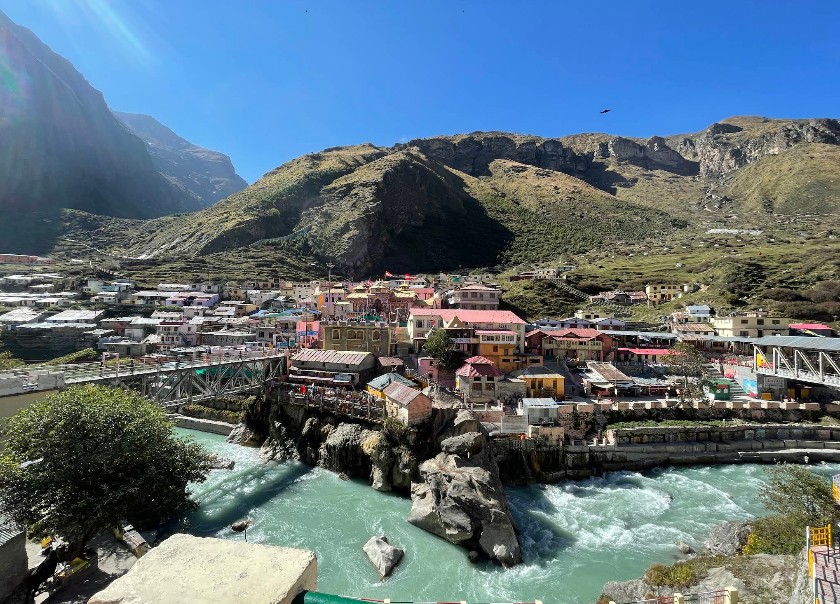
Though not located directly in Rishikesh, Badrinath Temple is often included in extended pilgrimages starting from the city. Situated about 300 km away, this sacred Char Dham site dedicated to Lord Vishnu is nestled in the Garhwal Himalayas. The journey itself is a spiritual adventure, taking you through winding mountain roads, forested valleys, and small Himalayan villages.The vibrant facade of temple, snow-capped backdrop, and serene Alaknanda River setting make it visually and spiritually unforgettable. The temple opens between April and November, drawing thousands of devotees. En route, pilgrims often visit Joshimath, Mana (last village of North India), and the origin of the Saraswati River. While the journey from Rishikesh to Badrinath takes 10 to 12 hours by road, it is often broken into a two-day itinerary. Whether you are seeking divine blessings or Himalayan peace, a visit to Badrinath offers a deep connection to an the ancient spiritual heritage and natural splendor of India.
Trekking to Valley of Flowers
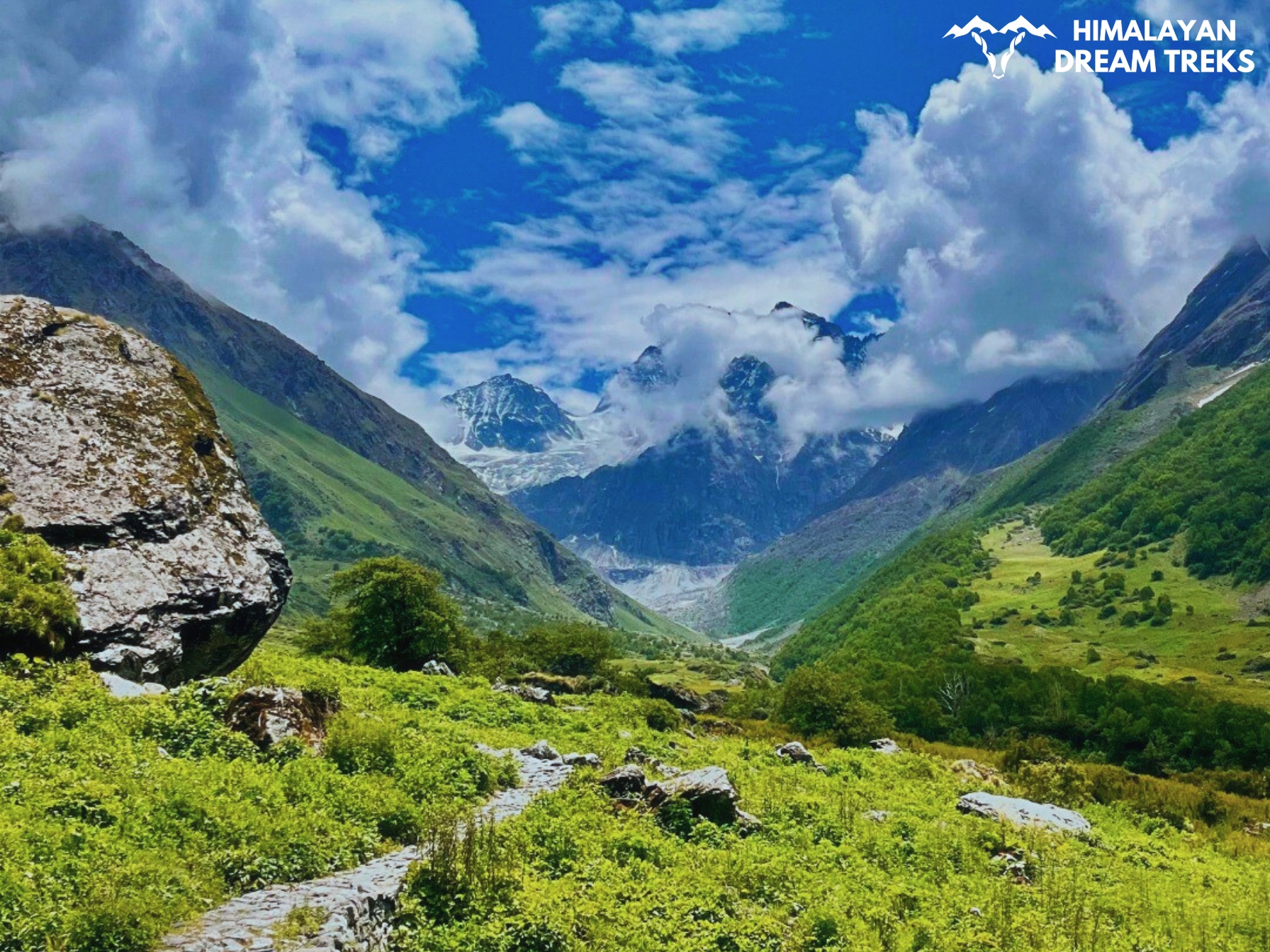
Tucked away in the high-altitude reaches of Uttarakhand, the Valley of Flowers is a breathtaking UNESCO World Heritage Site famed for its pristine natural beauty. Known for its vibrant meadows bursting with wildflowers, this alpine wonderland attracts trekkers, photographers, and botanists from all over the globe.
The journey begins at Govindghat, from where a scenic 9 km trail winds its way through dense forests, wooden bridges, and roaring glacial streams alongside the Pushpawati River. Trekkers ascend gradually to reach Ghangaria, the designated base camp for both the Valley of Flowers and the sacred Hemkund Sahib Gurudwara.
As you hike deeper into the valley, the landscape transforms into a surreal canvas of color to over 600 species of exotic flowers including orchids, poppies, primulas, and marigolds bloom across the undulating slopes. The sweet fragrance of blossoms mixes with the crisp Himalayan air, while the valley echoes with the calls of birds and the sound of distant waterfalls.
Towering peaks like Nilgiri Parbat and Rataban form a majestic backdrop, and mist-covered cliffs create an ethereal atmosphere. Visiting this valley during the monsoon months of July to early September ensures full bloom and vibrant greenery. The Valley of Flowers is not just a trek, it is an immersive journey into a living, breathing Himalayan paradise that stirs both awe and serenity.
Conclusion:
Triveni Ghat offers a rich blend of spirituality, culture and natural beauty. Whether you come for the legendary evening Aarti, to perform a holy dip, or simply to breathe in the serene riverside ambience, it encapsulates the devotional spirit of Rishikesh. As Incredible India summarizes, Triveni Ghat is a place where pilgrims from all walks of life come together and the flowing Ganga fills the air with ancient hymns. For tourists and spiritual seekers alike, a visit to Triveni Ghat is an unforgettable experience on the banks of the Ganges.
Written By:
Mountains Curve



Hotels at your convenience
Now choose your stay according to your preference. From finding a place for your dream destination or a mere weekend getaway to business accommodations or brief stay, we have got you covered. Explore hotels as per your mood.
